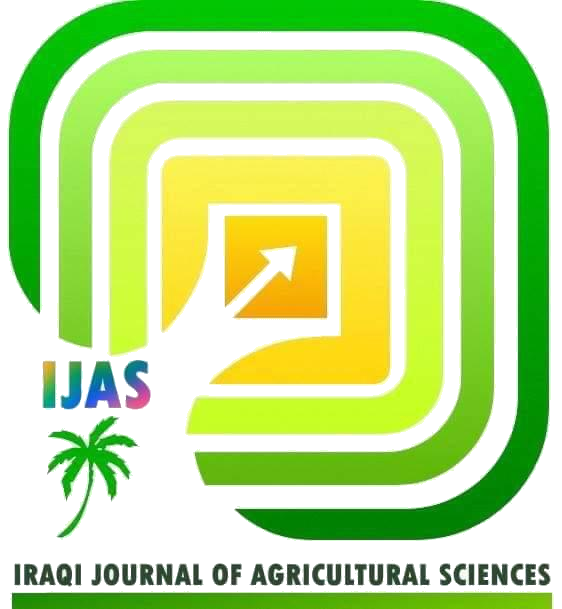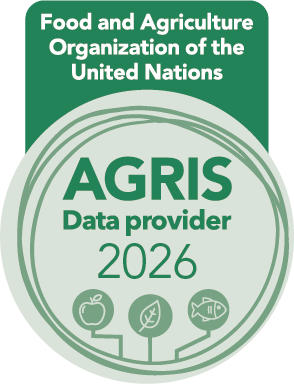FORAGE YIELD RESPONSE OF SOME GRASS PEA GENOTYPES TO ORGANIC FERTILIZER AND STUBBLE HEIGHT IN DIFFERENT ENVIRONMENTAL CONDITIONS OF SULAIMANI REGION- IRAQ
DOI:
https://doi.org/10.36103/skvya782Keywords:
Lathyrus sativus L., cutting height, dry forage yield, green forage yield, dry matter, fertilizer application, locations.Abstract
This study was conducted at two locations, Qlyasan Agricultural Research Station and Kanipanka Nursery Station, during the 2023–2024 winter season to investigate the effects of organic fertilizer and stubble height on forage yield attributes of grass pea genotypes. A split-split plot design was used with three factors: fertilizer application (F0= no fertilizer, F1= organic fertilizer), genotypes (G1: Local, G2: IGC-2011-62, G3: IGC-2011-35, G4: IGC-2011-9), and stubble height (SH1= 5cm, SH2 = 10cm). Fertilizer application significantly increased DFY in Kanipanka. Genotype significantly influenced most forage yield attributes, with G1 showing the highest values. Stubble height significantly affected GFY and DFY, particularly in Qlyasan. Kanipanka outperformed Qlyasan in key yield attributes. Cluster analysis identified two genotype groups, indicating genetic variability. Proper management of fertilizer. Interaction effects were observed for fertilizer × genotype and fertilizer × stubble height. Genotype selection and stubble height can optimize forage yield.
References
1. Ahmad, A., A., Wahid, F., Khalid, N., Fiaz, and M.S.I. Zamir, 2011. Impact of organic and inorganic sources of nitrogen and phosphorus fertilizers on growth, yield and quality of forage oat (Avena sativa L.). Cercetări Agronomice în Moldova, 44(3), 39–49. https://doi.org/10.2478/v10298-012-0040-7AGRIS
2. Abebe, T. G., M. R. Tamtam, A. A. Abebe, K. A. Abtemariam, T. G. Shigut, Y. A. Dejen,. and E. G. Haile, 2022. Growing use and impacts of chemical fertilizers and assessing alternative organic fertilizer sources in Ethiopia. Applied and Environmental Soil Science, 2022(1), 4738416. https://doi.org/10.1155/2022/4738416
3. Al-Doss, A., A., Assaeed and A. Soliman, 1998. Growth characters and yield of some selected lines of grass pea (Lathyrus sativus). Journal of King Saud University - Agricultural Sciences, 10(1), 67–72.
4. Campbell, C. G. 1997. Grass pea, Lathyrus sativus L. Bioversity International, 18.
5. Das, A., A. K., Parihar, S., Barpete, S., Kumar, and, S. Gupta 2021. Current perspectives on reducing the β-ODAP content and improving potential agronomic traits in grass pea (Lathyrus sativus L.). Frontiers in Plant Science, 12, 703275. https://doi.org/10.3389/fpls.2021.703275
6. Dutta, N., S. B., Neog, P. K., Barua, and V. K. Verma, 2024. Evaluation of grass pea (Lathyrus sativus L.) landraces for genetic variability and character association for growth, yield and quality attributes. Indian Journal of Plant Genetic Resources, 37(3), 502–512.
https://doi.org/10.61949/0976-1926.2024.v37i03.13
7. Genç Lermi, A., H. İ., Erkovan, and A. Koç, 2023. Determination of combined effects of organic and mineral fertilizer on forage yield and quality of annual ryegrass. Agronomy, 13(12), 2935. https://doi.org/10.3390/agronomy13122935
8. Hazra, G. 2016. Different types of eco-friendly fertilizers: An overview. Sustainability in Environment, 1(1), 54–70. https://www.scholink.org/ojs/index.php/se/article/view/327
9. He, Z., B. Ding, S. Pei, H. Cao, J. Liang, and Z. Li, 2023. The impact of organic fertilizer replacement on greenhouse gas emissions and its influencing factors. Science of The Total Environment, 905, 166917. https://doi.org/10.1016/j.scitotenv.2023.166917
10. Jiai, Liu, A. Shu, W. Song, W. Shi, M. Li, W. Zhang, , and Z. Gao, 2021. Long-term organic fertilizer substitution increases rice yield by improving soil properties and regulating soil bacteria. Geoderma, 404, 115287. https://doi.org/10.1016/j.geoderma.2021.115287
11. Kalita, H., and R. Chakrabarty, 2017. Performance of grass pea (Lathyrus sativus L.) varieties under different seed rates in rice (Oryza sativa)–utera situations. Journal of Crop and Weed, 13(1), 113–115.
12. Karim, S. F., S. R., Muhammed, and T. O. Muhammad, 2022. Influence of seeding rates and nitrogen application on growth, forage yield and its components of five vetch (Vicia sativa) varieties under rainfed condition of Sulaimani district-Iraq. Jilin Daxue Xuebao (Gongxueban)/Journal of Jilin University (Engineering and Technology Edition), 41(11), 233.
https://doi.org/10.17605/OSF.IO/J4AUR ].
13. Möller, K., and U. Schultheiß, 2015. Chemical characterization of commercial organic fertilizers. Archives of Agronomy and Soil Science, 61(7), 989-1012. https://doi.org/10.1080/03650340.2014.978763
14. Maleki, H. H., et al. 2024. Deciphering genotype-by-environment interaction of grass pea genotypes under rain-fed conditions and emphasizing the role of monthly rainfall. BMC Plant Biology, 24(1), 559. https://doi.org/10.1186/s12870-024-04431-8
15. Muhammed, S. A., S., Da–Sleman, and R. Hussaen, 2019. Response of some narbon vetch varieties to different defoliation intensities concerning forage, seed yield, and growth traits under rainfed conditions of the Sulaimani Governorate, Iraq. Applied Ecology and Environmental Research, 17(5), 12479–12490. https://doi.org/10.15666/aeer/1705_1247912490
16. Muhammed, S. R., and S. F Karim, 2021. The effect of harvesting stages and locations on seed yield and its components of some narbon vetch (Vicia narbonensis) lines under rainfed conditions of Sulaimani Governorate-Iraq. Zanco Journal of Pure and Applied Sciences, 33(S1), 1–10. https://doi.org/10.21271/zjpas
17. Muhammed, S. R., and S. F., Karim, 2020. Response of some Narbon vetch (Vicia narbonensis) lines to different harvesting stages for forage yield and its components at two locations of Sulaimani Governorate. Journal of Kirkuk University for Agricultural Sciences, 11(2), 45–56. https://doi.org/10.21271/jkucs.2020.11.2.4 .
18. Maleki, H. H., B., Vaezi, A., Jozeyan, et al. 2024. Deciphering genotype-by-environment interaction of grass pea genotypes under rain-fed conditions and emphasizing the role of monthly rainfall. BMC Plant Biology, 24(1), 559. https://doi.org/10.1186/s12870-024-05256-5SpringerLink+1BioMed Central+1
19. Shiferaw, E., M. E. Pè, E., Porceddu, and M. Ponnaiah, 2012. Exploring the genetic diversity of Ethiopian grass pea (Lathyrus sativus L.) using EST-SSR markers. Molecular Breeding, 30, 789–797. https://doi.org/10.1007/s11032-011-9662-ySpringerLink
20. Singh, T. B., et al. 2020. Role of Organic Fertilizers in Improving Soil Fertility. In Contaminants in Agriculture: Sources, Impacts, and Management pp. 61–77.
21. Sleman, S., S., Muhammed, D., Ahmad, and D. Abdulkhaleq, 2019. Evaluation of some grass pea genotypes (Lathyrus sativus L.) for forage, seed yield and its components under rainfed conditions in Sulaimani region. Tikrit Journal for Agricultural Sciences, 19(3), 35–46. https://doi.org/10.25130/tjas.19.3.6
22. Tawfiq, S., and S., Muhammed, 2014. Response of three cereal crops to different clipping times for forage yield at two locations of Sulaimani region. Zanko Sulaimani, 16, 23–32.
23. Saleque, M. A., M. J. Abedin, N. I. Bhuiyan, S. K. Zaman, and G. M. Panaullah, 2004. Long-term effects of inorganic and organic fertilizer sources on yield and nutrient accumulation of lowland rice. Field crops research, 86(1), 53-65. https://doi.org/10.1016/S0378-4290(03)00119-9
24. Vasileva, V., and O. Kostov, 2015. Effect of mineral and organic fertilization on alfalfa forage and soil fertility. Emirates Journal of Food and Agriculture, 27(9), 678–686. https://doi.org/10.9755/ejfa.2015.05.288 .
25. Wiersma, D., M., Bertam, R., Wiederholt, and N. Schneider, 2007. The long and short of alfalfa cutting height. Focus on Forage, 1(1), 1–4.
26. Yasuoka, J. I., W., Powell, W. H., Fick, and B. C. Pedreira, 2023. Impact of stubble heights on native hay meadows in southeast kansas. kansas agricultural experiment Station Research Reports, 9(2), 16. https://newprairiepress.org/kaesrr/vol9/iss2/16/New Prairie Press
27. Zhao, T., He, A., M. N., Khan, Q., Yin, S., Song, and L. Nie, 2024. Coupling of reduced inorganic fertilizer with plant-based organic fertilizer as a promising fertilizer management strategy for colored rice in tropical regions. Journal of Integrative Agriculture, 23(1), 93–107. https://doi.org/10.1016/j.jia.2023.04.035
28. Zhang, J. B., T. B. Zhu, Z. C. Cai, S. W Qin,., and C. Müller, 2012. Effects of long‐term repeated mineral and organic fertilizer applications on soil nitrogen transformations. European Journal of Soil Science, 63(1), 75-85.
https://doi.org/10.1111/j.1365-2389.2011.01410.x
29. Zhang, M., Y. Yao, Y. Tian, K. Ceng, M. Zhao, M. Zhao, and B. Yin, 2018. Increasing yield and N use efficiency with organic fertilizer in Chinese intensive rice cropping systems. Field Crops Research, 227, 102-109. https://doi.org/10.1016/j.fcr.2018.08.010
Downloads
Published
Issue
Section
License
Copyright (c) 2025 IRAQI JOURNAL OF AGRICULTURAL SCIENCES

This work is licensed under a Creative Commons Attribution-NonCommercial 4.0 International License.

2.jpg)


